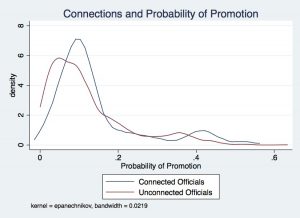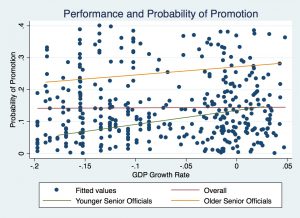One of the projects I worked during the summer with professor Ho was the role of connections and performance in China’s political selection. More specifically, we wanted to understand which of these traits dominates the other under different conditions.
To do this, we had to first develop a formal model to derive specific hypotheses. Our model was a relatively simple two period decision game where a senior official decides to promote from a pool of junior officials. We specified the senior official’s utility as the rent she obtains in both periods. However, we assumed that the rent she obtains in her second period is conditional on her surviving onto the next period. Here, we said that rent is a function of the junior official’s ability and the probability of survival is a function of the junior official’s connection status. Taken from a standard career concerns model in the industrial organization literature, we believed that ability is unobservable, but that the senior official can predict the true value of ability using the junior official’s performance. With this, we were able to derive the senior official’s expected utility given the junior official’s performance and connection status.
From this model, we obtained various propositions. The first was the both performance and connections matter, and an increase in either one would increase the junior official’s probability of promotion. The next propositions suggested that when the senior official has a larger external (exogenous) threat, an inaccurate performance signal, and a shorter time horizon, the value of connections would outweigh the value of performance.
To support the propositions derived from the model, we used a dataset from 1978-2012 that had all of China’s provincial (junior) officials as well as their connection status, performance, and promotion status. The dataset also included other characteristics that we used for controls as well as information on the senior officials. Using the dataset and various econometric strategies, we found that most of our hypotheses were supported. First, we found that connections (sons/son-in-laws) seemed to be positively correlated with the probability of promotion. However, performance (GDP growth rate of the junior official in his province) does not seem to impact the probability of promotion. Additionally, we found strong evidence that as the senior official becomes younger (and has a longer time horizon) or as the senior official receives an inaccurate measure of ability (high variance in performance) of the junior official, the value of connections for the junior official increases.



